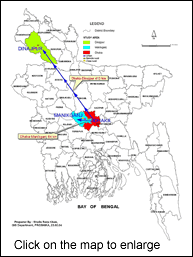


 |
| - Research Statement - Methods Toolbox - Countries - WeD Publications - WeD Working Papers - WeD Briefings - WeD Conference - Reference Database - Country Reports |


|
BANGLADESH
One of the most visible changes to occur in Bangladesh is the gradual urbanisation of the country. This is evidenced in the real increase of urban populations as well as the gradual coverage of new areas by urban growth. The expansion of the country’s capital epitomises this process. One of the consequences of this transformation is that there is a much more obvious sense of connectedness and integration in the country. The WeD Research in Bangladesh rests on the proposition that the process of connectedness and integration generates complex patterns of benefits and disadvantages. Two of the districts are distinguished by their distance
from Dhaka. The first district (Manikganj) is close to and enjoys
very good communication with Dhaka while the second (Dinajpur) is
quite distant from the capital and the communication is much more
restricted. In each of the two districts, we chose one urban site
(within the main town district) and two rural sites. One rural site
was chosen close to the main district town and the other far from
it in a remote site.
Bichitrapur is a village with approximately 350 households and is situated about 4.5 km from the district town of Manikganj. The majority of the population is Muslim although there is also a significant Hindu population with various castes and sub-castes. The village has one high school, four mosques, six temples and one market place. All of these are dispersed in various village quarters known locally as paras. Villagers are employed in a range of activities including farming, weaving, labouring, small businesses, official jobs (both governmental, non- governmental and private), education and health. Some households also have members working abroad. Overall facilities in the village are good but the well-to-do sections enjoy more and better quality services. Most of the internal roads are kacha (unpaved dirt roads), but a pakka road (paved) crosses through the village. This road allows villagers easy access to the district town.
Achingaon is located 18 km from the main urban administrative headquarters of Manikganj. There are records indicating that the village is at least 100 years old. The population is Muslim and there are approximately 250 households in the village. All of the households belong to one of 10 samajes (social groupings) present in the village. In terms of infrastructure, the village has very few facilities. There is no electricity, all the roads are kacha (unpaved dirt roads) and the level of overall sanitation is poor. The village has a mosque, a madrasha (Islamic school) and a primary school. Most villagers are employed in either agricultural activities or in small business ventures both inside and outside of the village. Migration is a major feature of village life with people moving either to Dhaka or abroad in search of employment. A number of Non Governmental Organisations are working in the village.
Aloknagar is an area that lies at the very heart of Manikganj. It is very close to the main road that leads to Dhaka, the capital city and therefore is an important site of commercial, administrative and political activities. It also contains an attractive and expensive residential area. Given that Aloknagar is an urban site, it offers a good level of basic services and amenities as well as more luxurious facilities. The population is very diverse in terms of religion, occupation and status. Some of the main social features associated with this site are high inequality, increasing drug addiction, political tension and a rise in religious fundamentalism.
Shantipur is 5km from the district town of Dinajpur and has approximately 800 households. 75% of the population are Muslims, 22% Hindus and 3% belong to a tribal group known as the Santals. The primary source of employment is agriculture and over 60% of the households depend on this for their survival. There is a modest level of services and amenities within the village. Some of the roads are paved and there is a market and bus stand very close to the village. Different NGOs are working in the village.
Telkupigaon has 750 households and is situated approximately 15km from Dinajpur. The population is 75% Muslim and 25% Hindu. The vast majority of the population depend primarily on agriculture as a source of income and employment. Services and amenities are scarce and only partially accessible. There is no nearby market or bus stand. A number of NGOs work in the village. Urban Site: Baniknagar |




